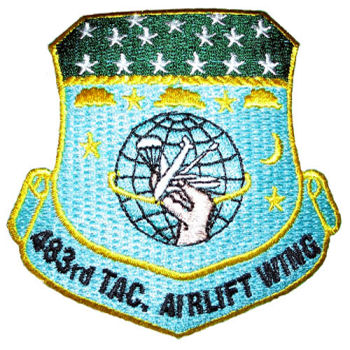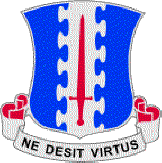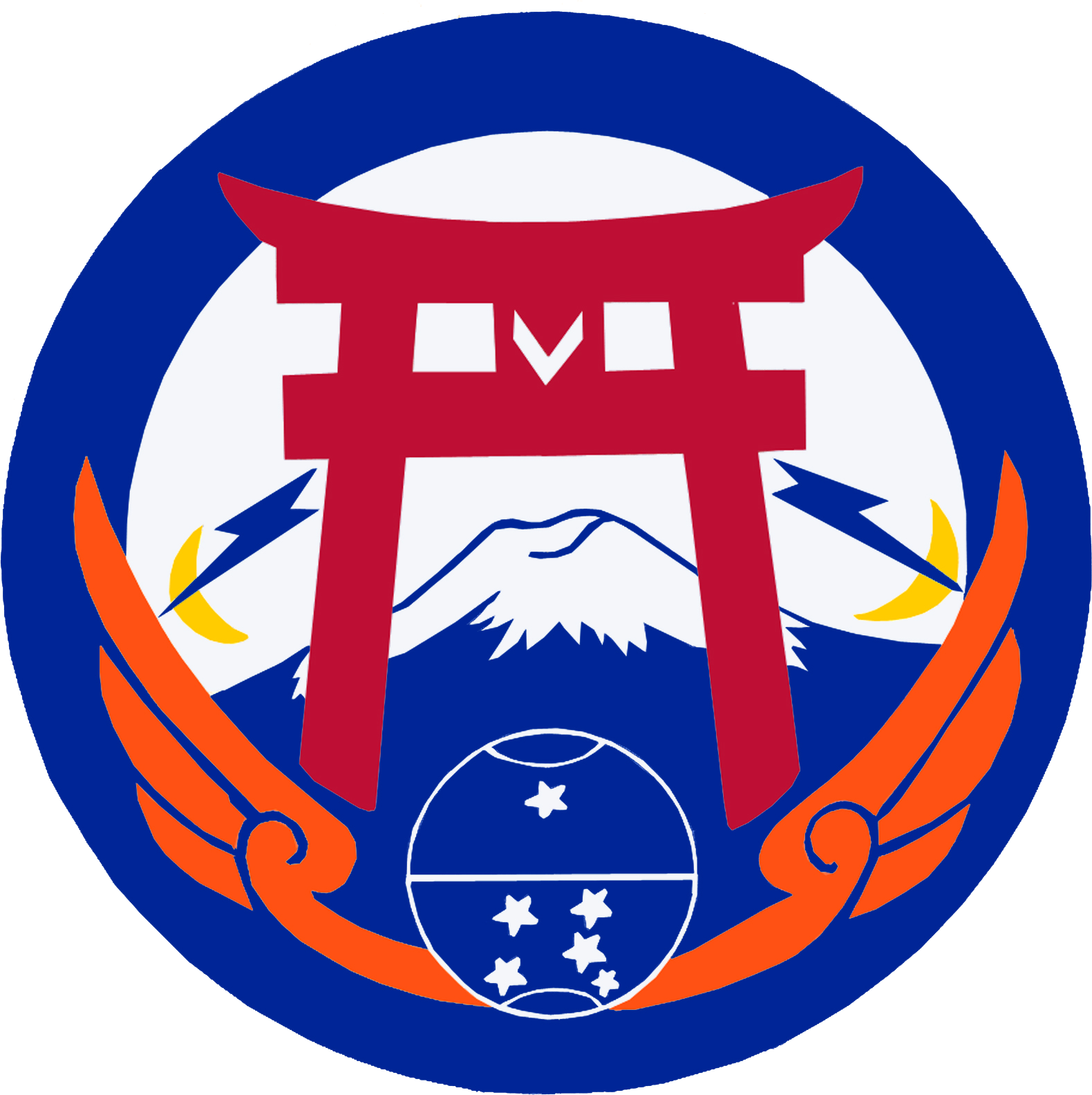|
483d Composite Wing
The 483rd Tactical Airlift Wing was a tactical airlift and composite wing assigned to Pacific Air Forces during the Vietnam War. It was the host organization at Cam Ranh Bay Air Base South Vietnam from 1970–1972. The unit history includes the temporarily bestowed history of the World War II 483rd Bombardment Group, which was a United States Army Air Forces combat group. It served primarily in the Mediterranean, African, and The Middle East Theatres of World War II. During the Korean War, the group was redesignated the 483rd Troop Carrier Group and assigned to the wing. The Wing was first organized as the 483rd Troop Carrier Wing during the Korean War, as an airlift organization assigned to Far East Air Forces (later Pacific Air Forces) (PACAF) for duty. History Korean War The wing was activated at Ashiya AB, Japan as the 483rd Troop Carrier Wing on 1 January 1953 and replaced the 403rd Troop Carrier Wing, Medium and absorbed the 403rd's mission, personnel and equipment. ... [...More Info...] [...Related Items...] OR: [Wikipedia] [Google] [Baidu] |
C-7A Caribou
The de Havilland Canada DHC-4 Caribou (designated by the United States military as the CV-2 and later C-7 Caribou) is a Canadian specialized cargo aircraft with STOL, short takeoff and landing (STOL) capability. The Caribou was first flown in 1958 and although mainly retired from military operations, is still in use in small numbers as a rugged bush airplane, "bush" aircraft. The design was further developed as the de Havilland Canada DHC-5 Buffalo, adding turboprop engines and other changes that further improved its short-field performance to the point where it competes with light aircraft even with a full load. Design and development The de Havilland Canada company's third STOL design was a big increase in size compared to its earlier DHC Beaver and DHC Otter, and was the first DHC design powered by two engines. The Caribou was similar in concept in that it was designed as a rugged STOL utility aircraft. The Caribou was primarily a military tactical transport that in comm ... [...More Info...] [...Related Items...] OR: [Wikipedia] [Google] [Baidu] |
483rd Bombardment Group
The 483rd Tactical Airlift Wing was a tactical airlift and composite wing assigned to Pacific Air Forces during the Vietnam War. It was the host organization at Cam Ranh Bay Air Base South Vietnam from 1970–1972. The unit history includes the temporarily bestowed history of the World War II 483rd Bombardment Group, which was a United States Army Air Forces combat group. It served primarily in the Mediterranean, African, and The Middle East Theatres of World War II. During the Korean War, the group was redesignated the 483rd Troop Carrier Group and assigned to the wing. The Wing was first organized as the 483rd Troop Carrier Wing during the Korean War, as an airlift organization assigned to Far East Air Forces (later Pacific Air Forces) (PACAF) for duty. History Korean War The wing was activated at Ashiya AB, Japan as the 483rd Troop Carrier Wing on 1 January 1953 and replaced the 403rd Troop Carrier Wing, Medium and absorbed the 403rd's mission, personnel and equipment. ... [...More Info...] [...Related Items...] OR: [Wikipedia] [Google] [Baidu] |
187th Regimental Combat Team
The 187th Airborne Infantry Regiment (Rakkasans) is a regiment of the 101st Airborne Division. , the 1st and 3rd battalions are the only active elements of the regiment; they are assigned to the 3rd Brigade Combat Team, 101st Airborne Division. World War II and aftermath The regiment was originally constituted as the 187th Glider Infantry Regiment on , and activated on at Camp Mackall, North Carolina. It was originally a two battalion glider regiment assigned to the 11th Airborne Division, the men of the 187th trained both as glider and parachute troops. They moved to Camp Polk on 9 January 1944 for glider training. The regiment staged at Camp Stoneman, California on 29 April 1944, and departed from the San Francisco Port of Embarkation on 6 May 1944. The regiment arrived in New Guinea on 29 May 1944 and joined the New Guinea Campaign. The regiment departed New Guinea on 11 November 1944, and arrived on Leyte on 18 November 1944 to join the Leyte Campaign. The regiment le ... [...More Info...] [...Related Items...] OR: [Wikipedia] [Google] [Baidu] |
C-119
The Fairchild C-119 Flying Boxcar (Navy and Marine Corps designation R4Q) was an American military transport aircraft developed from the World War II-era Fairchild C-82 Packet, designed to carry cargo, personnel, litter patients, and mechanized equipment, and to drop cargo and troops by parachute. The first C-119 made its initial flight in November 1947, and by the time production ceased in 1955, more than 1,100 C-119s had been built. Development The Air Force C-119 and Navy R4Q was initially a redesign of the earlier C-82 Packet, built between 1945 and 1948. The Packet provided service to the Air Force's Tactical Air Command and Military Air Transport Service for nearly nine years during which time its design was found to have several serious problems. All of these were addressed in the C-119. In contrast to the C-82, the cockpit was moved forward to fit flush with the nose rather than its previous location over the cargo compartment. This resulted in more usable cargo sp ... [...More Info...] [...Related Items...] OR: [Wikipedia] [Google] [Baidu] |
Fairchild C-119 Flying Boxcar
The Fairchild C-119 Flying Boxcar (Navy and Marine Corps designation R4Q) was an American military transport aircraft developed from the World War II-era Fairchild C-82 Packet, designed to carry cargo, personnel, litter patients, and mechanized equipment, and to drop cargo and troops by parachute. The first C-119 made its initial flight in November 1947, and by the time production ceased in 1955, more than 1,100 C-119s had been built. Development The Air Force C-119 and Navy R4Q was initially a redesign of the earlier C-82 Packet, built between 1945 and 1948. The Packet provided service to the Air Force's Tactical Air Command and Military Air Transport Service for nearly nine years during which time its design was found to have several serious problems. All of these were addressed in the C-119. In contrast to the C-82, the cockpit was moved forward to fit flush with the nose rather than its previous location over the cargo compartment. This resulted in more usable cargo s ... [...More Info...] [...Related Items...] OR: [Wikipedia] [Google] [Baidu] |
Far East Air Forces
Pacific Air Forces (PACAF) is a Major Command (MAJCOM) of the United States Air Force and is also the air component command of the United States Indo-Pacific Command (USINDOPACOM). PACAF is headquartered at Joint Base Pearl Harbor–Hickam (former Hickam AFB), Hawaii, and is one of two USAF MAJCOMs assigned outside the Continental United States, the other being the United States Air Forces in Europe – Air Forces Africa. Over the past sixty-five plus years, PACAF has been engaged in combat during the Korean and Vietnam Wars and Operations Desert Storm, Southern Watch, Northern Watch, Enduring Freedom and Iraqi Freedom. The mission of Pacific Air Forces is to provide ready air and space power to promote U.S. interests in the Asia-Pacific region during peacetime, through crisis, and in war. PACAF organizes, trains, and equips the 45,000 Total Force personnel of the Regular Air Force, the Air Force Reserve and the Air National Guard with the tools necessary to support the Comman ... [...More Info...] [...Related Items...] OR: [Wikipedia] [Google] [Baidu] |
315th Air Division
The 315th Air Division is an inactive United States Air Force formation. Originally designated the 315th Bombardment Wing, it was activated in July 1944 at Peterson Field, Colorado as a command and control organization for four very heavy B-29 Superfortress bombardment groups. It supervised the 16th, 331st, 501st and 502nd Bombardment Groups in the Mariana Islands during the last stages of the Second World War. Its last assignment was with Pacific Air Forces, based at Tachikawa Air Base, Japan. The division was inactivated in April 1969. History World War II The 315th Bombardment Wing was activated in July 1944 at Peterson Field, Colorado as a command and control organization for four very heavy Boeing B-29 Superfortress bombardment groups. The wing trained in Colorado while subordinate groups were trained in Kansas by Second Air Force. When training was completed, the wing headquarters moved to Guam in the Mariana Islands of the Central Pacific Area in late March 1945. The 315t ... [...More Info...] [...Related Items...] OR: [Wikipedia] [Google] [Baidu] |






